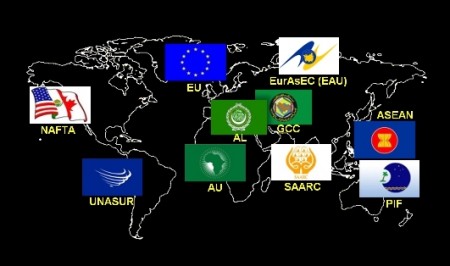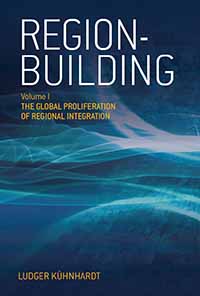Forget ‘Nation-Building’ – Now it’s ‘Region-Building’ 
By Tim Porter CircumspectNews.com, December 26, 2011 (Links Update Jan. 31)
Americans have developed an increasing weariness to our military’s continual involvement in “nation-building” over the past several decades. Even though the past three presidents won election in part on campaigns to reign in the practice, our armed forces continue to be sent off to a seemingly endless number of new locations throughout the world.
Bill Clinton’s election benefited from an increasing impatience with GHW Bush’s preoccupation with foreign affairs and nation-building, as reflected in the curt ’92 election slogan, “It’s the economy, stupid.” But Clinton did his own nation-building in the Balkans, allowing George W Bush to ride public opinion with his promise of “a more humble foreign policy” that would forsake nation-building.
For a time, the perceived threat in Iraq tempered America’s distaste for nation-building, as the war’s destruction lent credence to the Bush rebuilding program for that nation’s infrastructure. The same has been true with our involvement in Afghanistan. However, the results in both Iraq and Afghanistan have not been to the level that most Americans would expect as meriting exception to their disfavor of nation-building.
What exactly are the U.S. objectives in all of these military deployments? Is the price in blood and treasure being sacrificed simply for a “war on terror,” or are ulterior motives being pursued? President Obama’s latest deployment announcements confirm the latter, and shed broader light upon this habitual misuse of our military.
U.S. armed forces are now being sent to east Africa and Australia. In Africa, they will provide support for the African Union and its five-nation East African Community sub-region in their military’s offensive against the Lord’s Resistance Army. The LRA’s atrocities continue to cause friction and consternation for the five member nations of the EAC and their neighbors to the north and west. The LRA (along with the FDLR in the Congo) is an impediment to the sub-region’s stated goal of monetary integration in 2012, and political federation by 2015.
In Australia, American military presence is meant to settle tensions in the uncomfortable maritime negotiations between members of the ten-nation ASEAN (Association of Southeast Asian Nations) and China concerning disputed territorial claims on the South China Sea. In the past, China preferred to deal with each nation unilaterally but the promise of an American presence has prompted the more timid nations to demand negotiations corporately through ASEAN.
China has not reacted as if the U.S. presence will be a serious belligerence. Indeed, it appears as though the U.S. is doing China a service, as the Chinese are cheering ASEAN’s moves toward regionalization. ASEAN now is moving ahead on its goal of a European Union-style “Asian Community” by 2015, and China is out front in making the case for an “ASEAN Plus 3” (China, Japan, South Korea) free trade area.
The U.S. presence will also benefit the less-developed Pacific Islands Forum region, comprised of Australia and surrounding South Pacific island nations that have been wary of Australia’s dominance in the region.
In reality, these new deployments in Africa and Australia confirm that the United States is more involved in “region-building” than in nation-building. In retrospect, it appears that region-building with foreign aid and military presence has been America’s policy since the Marshall Plan for Western Europe after World War II.
Ostensibly guarding Western Europe from the Soviet threat, American military presence during the Cold War also encouraged the development of Europe’s Common Market into the present European Union, the prototype for all of today’s geopolitical regions. As globalist Rhodes Scholar Strobe Talbott, Clinton’s Deputy Secretary of State and roommate at Oxford, explained in a 1992 Time Magazine editorial, “The cold war also saw the European Community pioneer the kind of regional cohesion that may pave the way for globalism.
The current advancement of the six-nation Gulf Cooperation Council (GCC) toward its goal of a common currency, along with a regional military force, could not have been so rapid without the presence of the U.S. military providing umbrella support throughout the region, chiefly in Saudi Arabia and Kuwait, along the western shore of the Persian Gulf opposite Iran.
Certainly, the U.S. conflict in Afghanistan is having its effect on SAARC (the South Asian Association for Regional Cooperation). Both Afghanistan and Pakistan are being prodded toward more regional cooperation with other SAARC members, including India. Pakistan recently granted India most favored nation trade status.
America’s official and covert actions have spawned many of the events in the “Arab Spring” uprisings that now see the Arab League asserting itself to a degree never before seen since its inception. It recently found its voice in its ultimatum to Syria’s Bashar al-Assad.
America’s global military hegemony could even be said to have prompted the rapid rise of EurAsEC (Eurasian Economic Community) and its proposed “Eurasian Union” of former Soviet states by 2015. Vladimir Putin’s Russia is determined to challenge not only the European Union, but also America’s sole superpower status.
Such adversarial and competitive motivations are not discouraged in the construction of this New World Order of regions. Indeed, these attitudes are often employed as useful tools to prod the regions into deeper integration to keep up with their competition.
Another example of this motivation is in the development of UNASUR (Union of South American Nations). Reaction against U.S. hemispheric hegemony has brought about a determination by the southern continent to assert its separation and distinction from what it considers the overbearing north.
There have been two recent developments out of Washington concerning the military’s region-building. First, Congress passed the 2012 National Defense Authorization Act, which includes the assertion that the entire world – even the United States – is a battlefield in the “war on terror.” This definition permits deployment of the U.S. military within the U.S., overriding Posse Comitatus.
Second, Obama’s recently announced Beyond the Border Agreement with Canada establishes a security perimeter around the U.S. and Canada that was originally proposed by George W. Bush and the Council on Foreign Relations in 2005, with eased border restrictions between the two nations. Beyond the Border allows cross-border law enforcement, building upon a 2008 proviso for cross-border military deployments. Together, these enactments allow the U.S. military to continue its region-building – this time in North America.
Our military’s faithful mission to “support and defend the Constitution of the United States against all enemies, foreign and domestic,” has been co-opted. The military now receives orders from Machiavellian, utopian dreamers, determined to destroy our Constitution and the sovereignty of nations, stealing the resources and wealth of nations to build regions with puppet bureaucrats and parliaments that do the bidding of unaccountable oligarchs.
Case in point: Who appoints the NAFTA tribunals that have power to overturn Supreme Court rulings? *********************************************************************************************************************************************  More confirmation of the concerted drive toward regionalization is found in the two-volume text entitled REGION-BUILDING: The Global Proliferation of Regional Integration, published in July, 2010. It’s author, Bonn University political science professor Ludger Kühnhardt, is a European Union advocate and insider, having been a consultant for the secretary general of the Council of Europe and for the president of the European Parliament.
More confirmation of the concerted drive toward regionalization is found in the two-volume text entitled REGION-BUILDING: The Global Proliferation of Regional Integration, published in July, 2010. It’s author, Bonn University political science professor Ludger Kühnhardt, is a European Union advocate and insider, having been a consultant for the secretary general of the Council of Europe and for the president of the European Parliament.
The text describes the globalists’ motives for regionalization, gives an overview of all the world’s major regions and sub-regions, and describes the agreements and treaties that have incrementally phased these regions into existence.
The book summary begins with the following:
After two centuries of nation-building, the world has entered an era of region-building in search of political stability, cultural cohesion, and socio-economic development. Nations involved in the regional structures and integration schemes that are emerging in most regions of the world are deepening their ambitions, with Europe’s integration experience often used as an experimental template or theoretical model.
